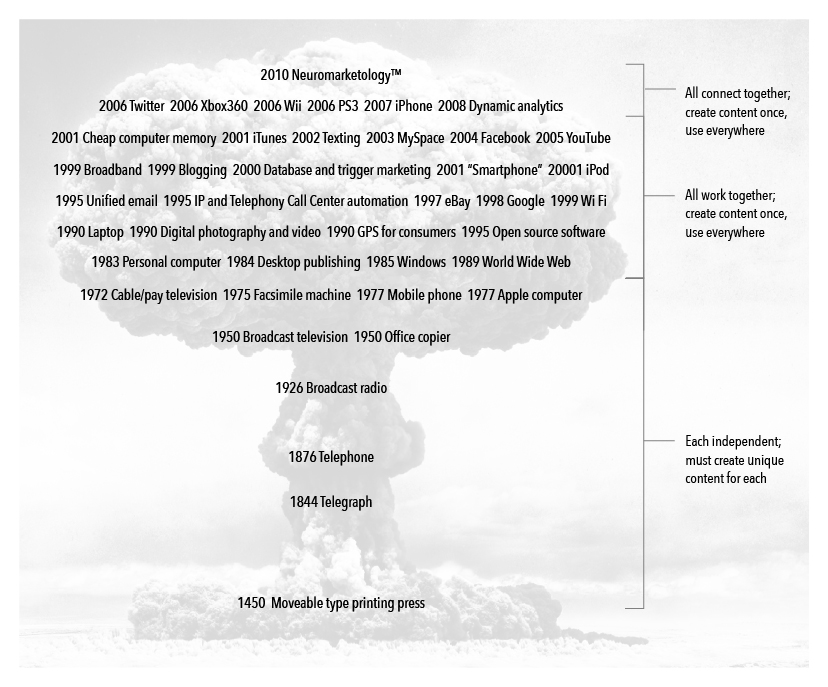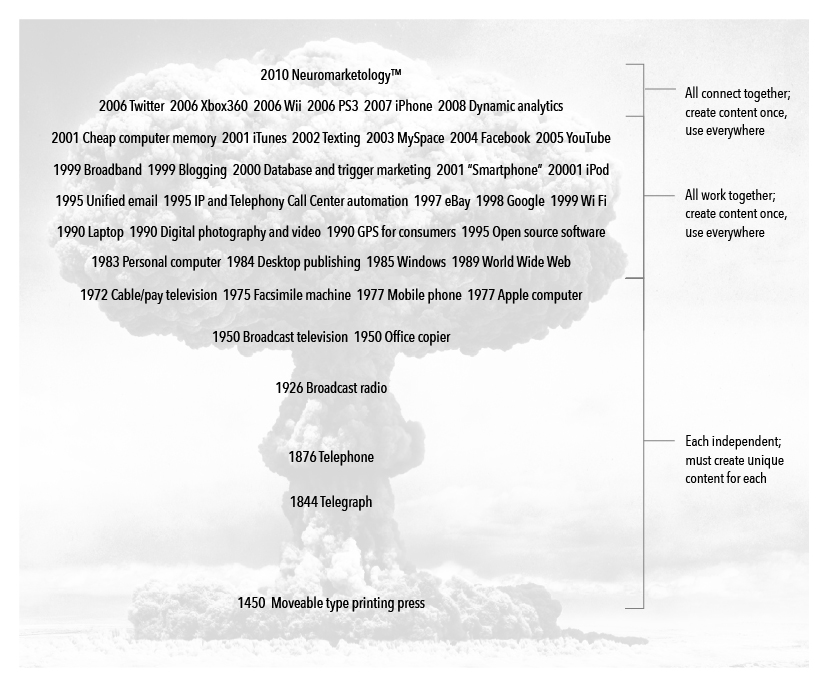
Marketing White Paper
Automated Dynamic Personalized Marketing
Innovation’s Role In Effective Marketing
The new “holy grail of marketing” is creating a dialogue with your customer, based on matching your brand’s attributes with a customer’s wants and needs, and then communicating with them on their terms, in the place of their choosing.
But, before we get to the “how-to” of this new paradigm, first, we must understand where we are, how fast we’re moving, and we need to know where we have been. Long before Apple debuted the original APPLE, which spurred the desktop revolution, Wang was offering word processing (nonlinear typesetting). The innovation was not connected to a cohesive graphical interface, nor was it natively compatible with page layout applications. Therefore, desktop publishing was considered and rejected as not fitting the needs of the publishers at the time. The technology was relegated to the label of fancy typewriter and was set aside as an outtake, a detour in the long journey toward office workplace efficiency.
The progression of the technology proceeded, but when the final dots were connected to generate the desktop revolution, established companies and industry leaders still declared they were not yet ready for prime time. This pessimistic assessment was based on their knowledge and experiences before the last dots were connected—that is, before the final breakthroughs that yielded the real efficiencies that would transform the industry. They hadn’t experienced the newest iteration, so they were still bound by previous experience, even though the technology had moved on.
Sound familiar? In the early days of desktop publishing, FabCom was an evangelist for adopting that work-flow and the gains it provided our clients. While introducing desktop publishing in the Southwest region, we felt the sting of many arrows fired our way. The established big guys in the industry discredited our message, mostly, we now understand, because of their enormous investments in the old ways and old infrastructure. By criticizing us as early adopters, they were able to buy time in the mind of the market until they could shift their organizations to acceptance, investment, training and efficiency.
Resistance Goes Hand-In-Hand With Innovation
It happened again in the 1990s with the early days of the World Wide Web. At that time, we developed strategic plan after plan, debuting online strategies for our clients. We faced constant resistance from prospective clients who based their opinions on conventional thinking and conventional experiences. We would recommend laying claim to the online space, building websites, grabbing key words and URLs, putting business processes online and opening up an online store, to name a few. Inevitably, we would be told “my customers do not use the Web.”
We would show them hard research. We would show them the mushroom cloud of general market acceptance and proliferation. We would show them charts and graphs of their specific customers’ profiles illustrating that they had indeed moved to acceptance of the Internet. We would demonstrate case study after case study on the power of early adoption. In the end, if the potential customer did not have experience with leveraging the World Wide Web to connect their brand to the public and only had conventional funnels, their status quo paradigms would get reinforced because the only customers they continued to accumulate were also customers who were late adopters. They would then put together customer surveys of their existing customers and turn around and say: “see, our customers do not use the Internet.”
Fortunately, we were very successful with the clients who trusted us and did not protect their old ways, old suppliers and old experiences, based on conventional wisdoms created before the innovation in question was ever available. We grew many multi-million dollar brands for those customers. Some did it just because of the trust we had built with them and were rewarded handsomely. Others did it because they caught the vision and could imagine what could be accomplished if they pursued an online strategy. These customers understood that a progressive 30-person agency in Scottsdale, AZ might just be ahead of the innovation curve and that there was a tipping point and that our firm could help them capitalize on it.
A Meaningful Marketing Conversation
This same phenomenon is happening again as I move from industry to industry introducing and implementing new dynamic 1-to-1 marketing approaches. Today, creating a dialog with your customer based on matching your brand attributes with the customers’ wants and needs, and then communicating with them on their terms in the place of their choosing, is the new holy grail of marketing.
It is what great salespeople do on a one-to-one basis. They understand exactly the difference between each person they are speaking with, and they understand their brand attributes and product features and benefits. They simply adjust the delivery of matched qualities within the offer and the type of customer they are speaking with, based on the expressed desires of the particular person they are engaging. This technology revolution allows us to create this kind of hyper-relevancy now on a mass basis with absolute consistency and scalability. Once we do the deep dive and map your brand attributes into dynamically generated customer segmentations, you can be assured you are delivering exactly the right message in exactly the right place in exactly the right time for each prospect or customer.
 Media platforms are becoming increasingly interconnected, which is conducive to creating meaningful dynamic 1 to 1 marketing conversations with individual customers.
Media platforms are becoming increasingly interconnected, which is conducive to creating meaningful dynamic 1 to 1 marketing conversations with individual customers.
A Technological Tidal Wave
The efficiency and power of the technology convergence over the last couple of years in the areas of database, software development, bandwidth, personal output devices, wireless connectivity, analytics, and real-time server reactivity to a customer’s interactions with a brand, has created a tidal wave of capability that cannot be avoided or ignored.
Many technologies from multiple industry sectors have converged to create a synergy in the most classic sense of the word. Marketers are already utilizing pieces and parts of the new capability. But the true power and return on investment comes from linking these functions together to enable your brand to resonate in a dialogue with your customers and prospects. This is, instead of publishing propaganda within the deluge of one to many messages that customers routinely ignore, never even getting to, or considering the core branding question: “Is this right for me?” The brand mapping of Neuromarketology™ and deploying an integrated 1-to-1 marketing work-flow will be as accepted as desktop publishing and the advent of the World Wide Web were. This is a fast-moving train. If you don’t get on board now, you’ll be left in the dust by competitors who seize the market gains of meeting your customers where they are, on their terms.
Fifty Percent More Earns You 200 Percent In Marketing ROI
It is easy to kid yourself with, “We’re already doing that.” But if you are not driving 200 percent more results out of each marketing dollar versus what you accomplished a couple of years ago, then you are not tapping into the synergistic power that makes this a revolutionary approach with exceptional results. If you are not investing the extra 50 percent and getting a 200 percent increase in response, it means you have deployed only a piece or two. Or, you have not powered your initiative with an accurate strategy. Or, you have not linked your resources to drive out all the connectivity that really creates the one-to-one messaging accuracy and added marketing ROI. It is an easy equation: Invest 50 percent more in the initial investment of mapping messaging and creative to all the facets of your brand, open up the revenue channels and receive 200 percent more income, customers, response, sign-ups or whatever goal you’re trying to achieve. When your brand starts to dialogue with relevancy, versus shouting one message from the rooftop, then you will begin to congregate your segments and expand your revenue.
Neuromarketology™ Brings All The Pieces Together
We see marketer after marketer, agency after agency, delude themselves and their companies with pieces of the puzzle that never deliver on the unprecedented opportunity of the whole. I don’t want you to make that error. You know there is a unique methodology in deploying Neuromarketology™ in your marketing, especially if you are a small to mid-size business owner or manager with marketing responsibilities. My intention isn’t to discourage you.
On the contrary, I want to assure you that the return is more than worth the effort. Today, any size business can take advantage of the competitive benefits of Neuromarketology™. Even a small business, unlikely to have the resources to fully implement the breakthrough methodology and technology, can reap the benefits by engaging the few firms like ours that have the resources in place to effectively deploy the concepts of Neuromarketology™.
For large businesses, assembling the required methodology, technology and expertise may make excellent strategic and financial sense in the long-run. Proceed with your eyes wide open. It takes different kinds of strategy. It takes different kinds of creative and it takes different kinds of copywriting. And, it cannot be accomplished via an IT department designed to service the core business as defined in conventional terms. Neuromarketology™ requires an IT work-flow and IT workforce that operates on marketing time with the attitudes and urgency of marketing teams. That’s a whole different rhythm and pace than the rate at which IT teams traditionally take on and facilitate projects. If your IT department requires a work order before you can get something done, then do not even try to bring this into your company without guidance from experienced professionals who have already implemented the work-flow.
The right strategists, creatives, software, programmers, work-flows and servers are all specialized for the task of dynamic 1-to-1 marketing.
For our larger clients, we write the strategy, design the campaign and then provide templates for in-house expansions. In effect, we teach larger companies how-to fish the new way, augmenting the capability of the in-house marketing department.
For smaller organizations, this may be highly impractical, if not impossible. But small businesses can take heart in knowing that we have deployed these powerful campaigns for less than $25,000 for some clients. By understanding the opportunity now available, you can begin to deploy this methodology to your advantage, whether through in-house resources or by partnering with carefully selected strategic suppliers.
Organizations can now harness the rapidly expanding power of the Google Generation for growth instead of being overwhelmed by it. You can abandon the old paradigms, conventional wisdom and legacy technology of one to many marketing and utilize the concepts of Neuromarketology™ to dramatically increase the return on your marketing investment. At the same time, you can multiply your brand’s reach by utilizing the myriad variations of connections possible when we effectively cultivate one-to-one audience pools, instead of applying the methodology used in the past. When you deploy the brand mapping of Neuromarketology, media fragmentation is no longer a threat to your strategy. It’s an invaluable ally that you can leverage to deliver improved results more affordably and effectively. That’s the power Neuromarketology™ can bring you.
We have deployed these concepts in multiple market spaces in the last few years in the business-to-business and business-to-consumer environments, for both traditional and not-for-profit entities, for big businesses and small. We have deployed this new methodology to market a $30 nutritional supplement, as well as to increase enrollment for a prestigious private university. It has worked for delivery companies, resort properties, retail, credit unions, and insurance companies. Customers just want to know one thing when making a purchase, and it’s the same thing for every purchase: “Is this product or service right for me?” When you answer that question with superior relevance, timing and placement, sales soar.